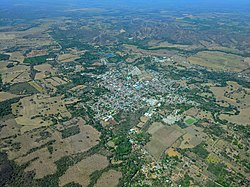Santa Cruz (canton), Costa Rica
Santa Cruz | |
|---|---|
 The town of Santa Cruz, administrative center of the canton and district of Santa Cruz | |
 Santa Cruz canton | |
| Coordinates: 10°14′09″N 85°38′27″W / 10.2357596°N 85.6407774°W | |
| Country | |
| Province | Guanacaste |
| Creation | 7 December 1848[1] |
| Head city | Santa Cruz |
| Districts | |
| Government | |
| • Type | Municipality |
| • Body | Municipalidad de Santa Cruz |
| Area | |
• Total | 1,312.27 km2 (506.67 sq mi) |
| Elevation | 39 m (128 ft) |
| Population (2011) | |
• Total | 55,104 |
| • Density | 42/km2 (110/sq mi) |
| Time zone | UTC−06:00 |
| Canton code | 503 |
| Website | santacruz |
Santa Cruz is a canton in the Guanacaste province of Costa Rica.[2][3] The head city is in Santa Cruz district.
History
Santa Cruz was created on 7 December 1848 by decree 167.[1]
On September 5, 2012, Santa Cruz was struck by a magnitude 7.6 earthquake, destroying houses in the canton.[4][5]
Geography
Santa Cruz has an area of 1,312.27 km²[6] and a mean elevation of 39 metres.[2]
The heart-shaped canton is on the northern Pacific coast between Potrero Bay to the north and the mouth of the Montaña River to the south. It includes Velas Cape, the furthermost western point on the Nicoya Peninsula. The Tempisque River delineates a small portion of the eastern border.
Districts
The canton of Santa Cruz is subdivided into the following districts:
Demographics
| Census | Pop. | ±% p.a. |
|---|---|---|
| 1864 | 3,217 | — |
| 1883 | 4,748 | +2.07% |
| 1892 | 5,948 | +2.54% |
| 1927 | 10,390 | +1.61% |
| 1950 | 13,615 | +1.18% |
| 1963 | 23,576 | +4.31% |
| 1973 | 29,739 | +2.35% |
| 1984 | 31,133 | +0.42% |
| 2000 | 40,821 | +1.71% |
| 2011 | 55,104 | +2.77% |
| 2022 | 72,366 | +2.51% |
| Source: Instituto Nacional de Estadística y Censos[7] Centro Centroamericano de Población[8] | ||
For the 2011 census, Santa Cruz had a population of 55,104 inhabitants.[9]
Transportation
Road transportation
The canton is covered by the following road routes:
Festivals
The capital city of Santa Cruz, named Santa Cruz, is a typical Costa Rican rural town. Its inhabitants are very diverse and consist mostly of farmers, fishermen, workers or employees of several of the many hotels located in the vicinity. The town is known within Costa Rica for its cultural heritage and many historical traditions. These traditions include the Fiesta de Semana Santa (Easter week celebration) and the traditional bullfights as well as many others.
Every year in Santa Cruz there are a number of festivals which include bull riding ceremonies. These ceremonies, though traditional at heart, lack most of the features seen in Spanish bullfighting traditions. Usually the ring in which the bull is let loose is open to anyone, tourists as well as locals – man, woman or child. The bull riding usually starts with a man being placed on the bull with nothing but a string to hold on to. This man is inevitably, after some time, thrown off. Even though there are always medical personnel in place to supervise the bull riding, severe injuries or even death among the bullriders are not uncommon.[citation needed]
The bulls are treated with respect and dignity and in no bullring within Costa Rica is it ever alright to deliberately injure or kill a bull in a bullfight, whereas in Spain or Mexico the very purpose of the bullfight is for a trained professional to kill the bull.[citation needed]
The canton also includes the town of Santa Bárbara, known for its traditional annual dance of the calabashes (baile de los guacales). Since 2000 the activity has been considered of cultural interest to the community and all participants receive a hand-painted calabash vessel to thank them for their economic contribution (which they paid in the form of an entrance ticket).[10]
References
- ^ a b Hernández, Hermógenes (1985). Costa Rica: evolución territorial y principales censos de población 1502 - 1984 (in Spanish) (1 ed.). San José: Editorial Universidad Estatal a Distancia. pp. 164–173. ISBN 9977-64-243-5. Retrieved 5 October 2020.
- ^ a b "Declara oficial para efectos administrativos, la aprobación de la División Territorial Administrativa de la República N°41548-MGP". Sistema Costarricense de Información Jurídica (in Spanish). 19 March 2019. Retrieved 26 September 2020.
- ^ División Territorial Administrativa de la República de Costa Rica (PDF) (in Spanish). Editorial Digital de la Imprenta Nacional. 8 March 2017. ISBN 978-9977-58-477-5.
- ^ "M7.6 – 12km ENE of Hojancha, Costa Rica". United States Geological Survey. September 5, 2012. Retrieved October 3, 2012.
- ^ Mata Blanco, Alonso (September 6, 2012). "Sismo Destruyó Viviendas en Varios Cantones de Guanacaste y Alajuela" [Earthquake Destroyed Homes in Several Cantons of Guanacaste and Alajuela]. La Nación (in Spanish). Archived from the original on September 25, 2012. Retrieved October 3, 2012.
- ^ "Área en kilómetros cuadrados, según provincia, cantón y distrito administrativo". Instituto Nacional de Estadística y Censos (in Spanish). Retrieved 26 September 2020.
- ^ "Instituto Nacional de Estadística y Censos" (in Spanish).
- ^ Centro Centroamericano de Población de la Universidad de Costa Rica. "Sistema de Consulta a Bases de Datos Estadísticas" (in Spanish).
- ^ "Censo. 2011. Población total por zona y sexo, según provincia, cantón y distrito". Instituto Nacional de Estadística y Censos (in Spanish). Retrieved 26 September 2020.
- ^ "Baile del Guacal" [Dance of the Calabash]. La Nación (in Spanish). 1 July 2010.
External links
- "Santa Cruz Canton Map" Instituto de Fomento y Asesoría Municipal, 1984



